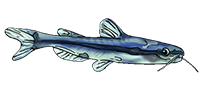L56 Parancistrus sp. bariancistrus aurancistrus
-
ACIDRAIN
- Posts: 2
- Joined: 14 Oct 2005, 15:43
- Location 1: Cincinnati, OH
- Interests: All fish
- Contact:
L56 Parancistrus sp. bariancistrus aurancistrus
Can anyone give me any info on these guys? I have a chance to aquire 3 of them. But cannot seem to find any info on them, other than a few pics. The more beneficial info I am looking for, is sexing them, along with aggressive nature, breeding, and the more advanced kind of stuff.
From my experience with the Parancistrus, these 3 all appear to be males, but I am hoping for some info telling me I am wrong.
Thanks for your time.
From my experience with the Parancistrus, these 3 all appear to be males, but I am hoping for some info telling me I am wrong.
Thanks for your time.
There is always a bigger fish. . .
- Silurus
- Posts: 12476
- Joined: 31 Dec 2002, 11:35
- I've donated: $12.00!
- My articles: 55
- My images: 903
- My catfish: 1
- My cats species list: 90 (i:0, k:0)
- Spotted: 433
- Location 1: Singapore
- Location 2: Moderator Emeritus
- MatsP
- Posts: 21038
- Joined: 06 Oct 2004, 13:58
- My articles: 4
- My images: 28
- My cats species list: 117 (i:33, k:0)
- My aquaria list: 10 (i:8)
- My BLogs: 4 (i:0, p:164)
- Spotted: 187
- Location 1: North of Cambridge
- Location 2: England.
Apparently, males can be differentiated by the fact that they are golden when they are in good condition.
Other than that, it doesn't appear to be easy to sex these guys. Of course, the general rules of sexing loricariidae still applies: Males are more likely to have odontal ("hair") growth on pectoral fins, gill-covers, back-end, etc. But not all of these are present on all species, and the condition of the fish also affects the details of the sex.
Maybe you can buy a trio and see if you can give us some more details on how to sex them?
--
Mats
Other than that, it doesn't appear to be easy to sex these guys. Of course, the general rules of sexing loricariidae still applies: Males are more likely to have odontal ("hair") growth on pectoral fins, gill-covers, back-end, etc. But not all of these are present on all species, and the condition of the fish also affects the details of the sex.
Maybe you can buy a trio and see if you can give us some more details on how to sex them?
--
Mats
L056 origin
Hi -
Is L056 collected in the same place as Parancistrus aurantiacus? I can't seem to find much information on the L056.
Jeri
Is L056 collected in the same place as Parancistrus aurantiacus? I can't seem to find much information on the L056.
Jeri
- Jools
- Expert
- Posts: 16303
- Joined: 30 Dec 2002, 15:25
- My articles: 198
- My images: 946
- My catfish: 237
- My cats species list: 88 (i:235, k:2)
- My BLogs: 7 (i:10, p:167)
- My Wishlist: 23
- Spotted: 453
- Location 1: Middle Earth,
- Location 2: Scotland
- Interests: All things aquatic, Sci-Fi, photography and travel. Oh, and beer.
- Contact:
Re: L056 origin
The two are the same thing.jellyfish wrote:Hi -
Is L056 collected in the same place as Parancistrus aurantiacus? I can't seem to find much information on the L056.
Jeri
Jools
Owner, AquaticRepublic.com, PlanetCatfish.com & ZebraPleco.com. Please consider donating towards this site's running costs.
Thanks Jools. The reason I ask is that I have read (but can't verify) that P. aurantiacus is collected from the Rio Tocantins and L056 is collected from the Rio Araguari(?).
If that's true and if all of the chubby/rubber plecos collected in the Araguari are brown/black, they are probably a different species than P. aurantiacus. If yellow fish are coming from both locations then it might just be a color variant or sex difference of the same fish.
Jeri
If that's true and if all of the chubby/rubber plecos collected in the Araguari are brown/black, they are probably a different species than P. aurantiacus. If yellow fish are coming from both locations then it might just be a color variant or sex difference of the same fish.
Jeri





